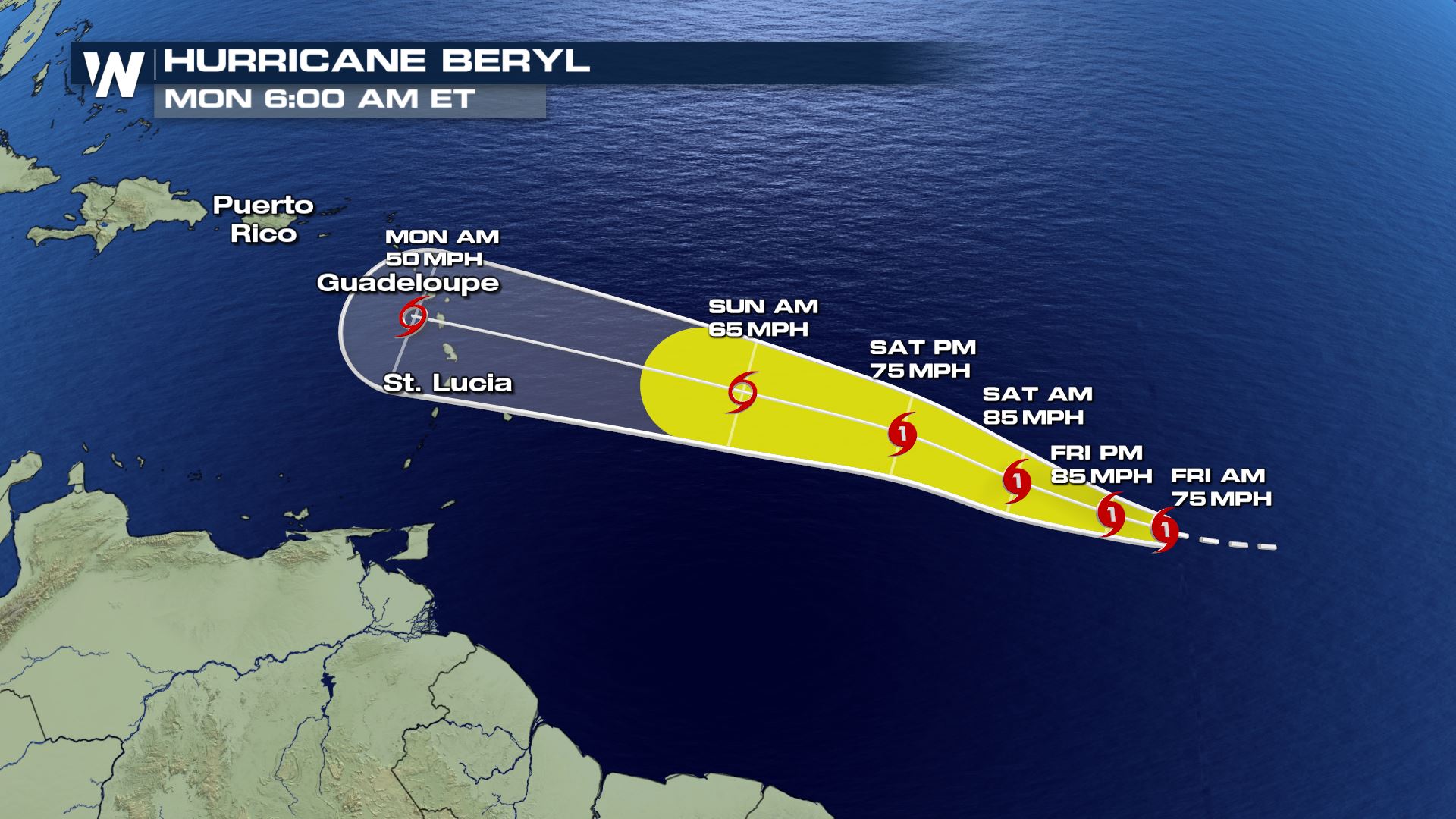Hurricane Beryl’s Projected Path and Intensity

Hurricane beryl forecast – Hurricane Beryl, currently a Category 1 storm, is projected to strengthen to a Category 2 hurricane within the next 24 hours. The storm is expected to continue on its current path, moving west-northwest at 15 mph. It is expected to make landfall in Florida on Tuesday evening.
The latest forecast for Hurricane Beryl indicates that it is expected to weaken as it approaches Florida. However, residents in the state should still be prepared for potential impacts. For more information on Hurricane Beryl’s expected path and potential impacts on Florida, visit hurricane beryl florida.
The hurricane is expected to bring heavy rainfall and possible flooding to the state, so it is important to stay informed and take necessary precautions.
Projected Path
The National Hurricane Center’s latest forecast track has Hurricane Beryl moving towards the Florida Panhandle. The storm is expected to make landfall near Panama City on Tuesday evening. After landfall, Beryl is expected to weaken as it moves inland, but it could still bring heavy rain and flooding to the southeastern United States.
Hurricane Beryl is expected to strengthen over the next few days. The hurricane beryl spaghetti models show that the storm could make landfall in Florida by the end of the week. The National Hurricane Center is urging residents to prepare for the storm and to stay informed about the latest forecasts.
Intensity Forecast
Hurricane Beryl is expected to strengthen to a Category 2 hurricane within the next 24 hours. The storm could reach Category 3 strength before making landfall on Tuesday. However, it is also possible that Beryl could weaken before reaching land.
Factors Influencing the Storm’s Movement and Development
The movement and development of Hurricane Beryl will be influenced by a number of factors, including:
- The strength of the steering currents in the atmosphere
- The temperature of the ocean water
- The interaction with other weather systems
Impact Analysis and Evacuation Plans

Hurricane Beryl has the potential to bring heavy rainfall, strong winds, and storm surge to affected areas. It is crucial to assess the potential impacts and implement appropriate evacuation plans to ensure the safety of residents.
Local authorities have identified potential evacuation routes and designated shelters to accommodate those who need to leave their homes. It is essential for residents to familiarize themselves with these plans and identify the nearest evacuation route and shelter in case of an emergency.
Evacuation Routes and Shelters
Evacuation routes are designated roads and highways that provide a safe path away from the storm’s impact zone. Residents should identify the evacuation route closest to their home and plan to use it if necessary. Evacuation shelters are public facilities, such as schools, community centers, and churches, that provide temporary shelter and basic necessities to evacuees.
- Residents should check with local authorities for specific evacuation routes and shelter locations.
- It is important to have a plan in place for where to go and how to get there in case of an evacuation order.
- Evacuees should bring essential supplies, such as food, water, medications, and important documents, with them when they evacuate.
Emergency Protocols
In the event of an evacuation order, residents should follow the instructions of local authorities and evacuate immediately. It is important to stay informed about the storm’s progress and follow the guidance of emergency responders.
- Residents should have an emergency plan that includes evacuation procedures, meeting places, and contact information for family members.
- It is important to have a battery-powered radio or NOAA weather radio to stay informed about the storm and any changes in evacuation orders.
- Residents should be prepared to evacuate for an extended period of time and bring necessary supplies with them.
Historical Context and Comparative Analysis: Hurricane Beryl Forecast
Hurricane Beryl’s recent formation has raised concerns, prompting comparisons to past hurricanes that have impacted the region. By examining similarities and differences in intensity, trajectory, and impact, we can gain valuable insights into the potential risks and appropriate response measures.
Comparative Analysis, Hurricane beryl forecast
In terms of intensity, Hurricane Beryl is currently classified as a Category 1 hurricane on the Saffir-Simpson Hurricane Wind Scale. While this is a relatively low category, historical records show that even Category 1 hurricanes can cause significant damage. For example, Hurricane Danny, which made landfall in the Gulf Coast in 1997, was also a Category 1 hurricane but resulted in widespread flooding and power outages.
Regarding trajectory, Hurricane Beryl is expected to follow a similar path to Hurricane Ivan, which devastated the Gulf Coast in 2004. Both hurricanes are projected to make landfall in the same general area, posing a significant threat to coastal communities.
Finally, the impact of Hurricane Beryl is likely to vary depending on its exact trajectory and intensity. However, historical data suggests that hurricanes making landfall in this region often bring heavy rainfall, storm surge, and high winds. These conditions can lead to flooding, property damage, and power outages.
